Comprehensive Essay: Business Ethics and Social Responsibility
VerifiedAdded on 2020/01/28
|10
|4107
|1980
Essay
AI Summary
This essay delves into the critical concepts of business ethics and social responsibility, exploring their significance in the modern business landscape. It examines the viewpoint of Harvard Schulz on business ethics, analyzing it through relevant theories and contemporary business examples. The essay defines corporate social responsibility (CSR) as an ethical framework, emphasizing the need to balance commerce with social responsibility. It highlights the importance of authentic business operations and ethical decision-making processes within organizations. Furthermore, the essay discusses the management of ethics in the workplace through established programs and explores key theoretical frameworks, including sustainable development theory, corporate social responsibility theory, and the triple bottom line theory, to provide a comprehensive understanding of the subject.
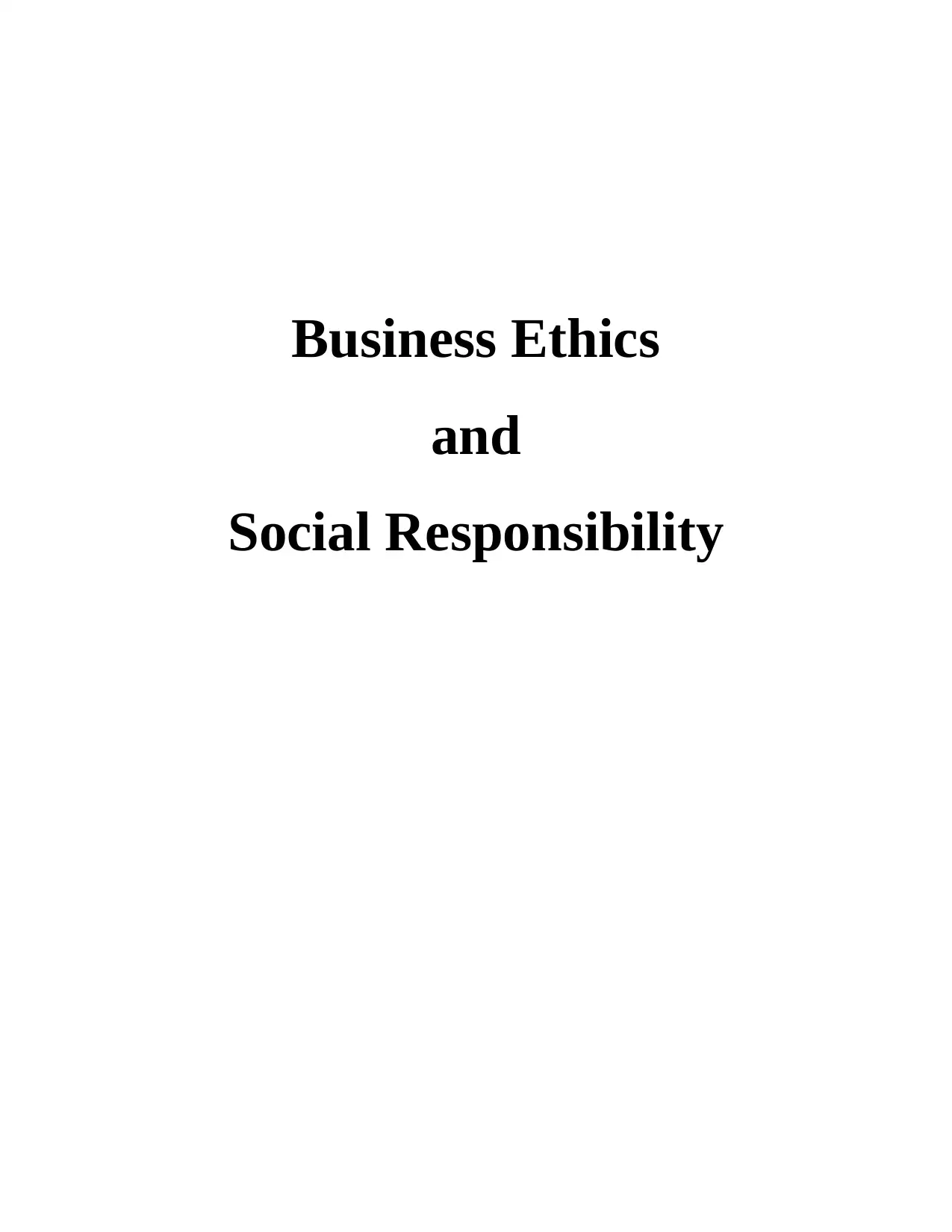
Business Ethics
and
Social Responsibility
and
Social Responsibility
Paraphrase This Document
Need a fresh take? Get an instant paraphrase of this document with our AI Paraphraser
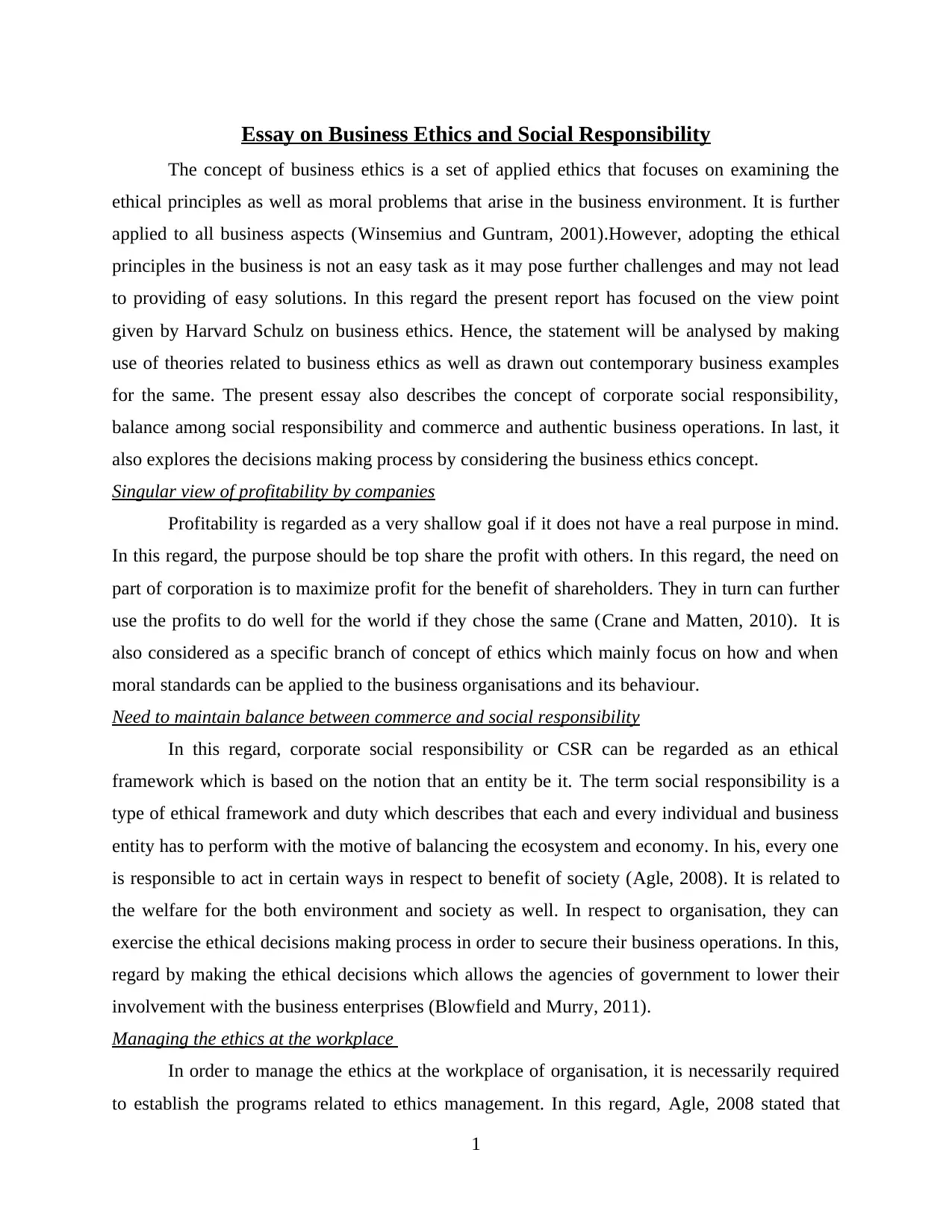
Essay on Business Ethics and Social Responsibility
The concept of business ethics is a set of applied ethics that focuses on examining the
ethical principles as well as moral problems that arise in the business environment. It is further
applied to all business aspects (Winsemius and Guntram, 2001).However, adopting the ethical
principles in the business is not an easy task as it may pose further challenges and may not lead
to providing of easy solutions. In this regard the present report has focused on the view point
given by Harvard Schulz on business ethics. Hence, the statement will be analysed by making
use of theories related to business ethics as well as drawn out contemporary business examples
for the same. The present essay also describes the concept of corporate social responsibility,
balance among social responsibility and commerce and authentic business operations. In last, it
also explores the decisions making process by considering the business ethics concept.
Singular view of profitability by companies
Profitability is regarded as a very shallow goal if it does not have a real purpose in mind.
In this regard, the purpose should be top share the profit with others. In this regard, the need on
part of corporation is to maximize profit for the benefit of shareholders. They in turn can further
use the profits to do well for the world if they chose the same (Crane and Matten, 2010). It is
also considered as a specific branch of concept of ethics which mainly focus on how and when
moral standards can be applied to the business organisations and its behaviour.
Need to maintain balance between commerce and social responsibility
In this regard, corporate social responsibility or CSR can be regarded as an ethical
framework which is based on the notion that an entity be it. The term social responsibility is a
type of ethical framework and duty which describes that each and every individual and business
entity has to perform with the motive of balancing the ecosystem and economy. In his, every one
is responsible to act in certain ways in respect to benefit of society (Agle, 2008). It is related to
the welfare for the both environment and society as well. In respect to organisation, they can
exercise the ethical decisions making process in order to secure their business operations. In this,
regard by making the ethical decisions which allows the agencies of government to lower their
involvement with the business enterprises (Blowfield and Murry, 2011).
Managing the ethics at the workplace
In order to manage the ethics at the workplace of organisation, it is necessarily required
to establish the programs related to ethics management. In this regard, Agle, 2008 stated that
1
The concept of business ethics is a set of applied ethics that focuses on examining the
ethical principles as well as moral problems that arise in the business environment. It is further
applied to all business aspects (Winsemius and Guntram, 2001).However, adopting the ethical
principles in the business is not an easy task as it may pose further challenges and may not lead
to providing of easy solutions. In this regard the present report has focused on the view point
given by Harvard Schulz on business ethics. Hence, the statement will be analysed by making
use of theories related to business ethics as well as drawn out contemporary business examples
for the same. The present essay also describes the concept of corporate social responsibility,
balance among social responsibility and commerce and authentic business operations. In last, it
also explores the decisions making process by considering the business ethics concept.
Singular view of profitability by companies
Profitability is regarded as a very shallow goal if it does not have a real purpose in mind.
In this regard, the purpose should be top share the profit with others. In this regard, the need on
part of corporation is to maximize profit for the benefit of shareholders. They in turn can further
use the profits to do well for the world if they chose the same (Crane and Matten, 2010). It is
also considered as a specific branch of concept of ethics which mainly focus on how and when
moral standards can be applied to the business organisations and its behaviour.
Need to maintain balance between commerce and social responsibility
In this regard, corporate social responsibility or CSR can be regarded as an ethical
framework which is based on the notion that an entity be it. The term social responsibility is a
type of ethical framework and duty which describes that each and every individual and business
entity has to perform with the motive of balancing the ecosystem and economy. In his, every one
is responsible to act in certain ways in respect to benefit of society (Agle, 2008). It is related to
the welfare for the both environment and society as well. In respect to organisation, they can
exercise the ethical decisions making process in order to secure their business operations. In this,
regard by making the ethical decisions which allows the agencies of government to lower their
involvement with the business enterprises (Blowfield and Murry, 2011).
Managing the ethics at the workplace
In order to manage the ethics at the workplace of organisation, it is necessarily required
to establish the programs related to ethics management. In this regard, Agle, 2008 stated that
1
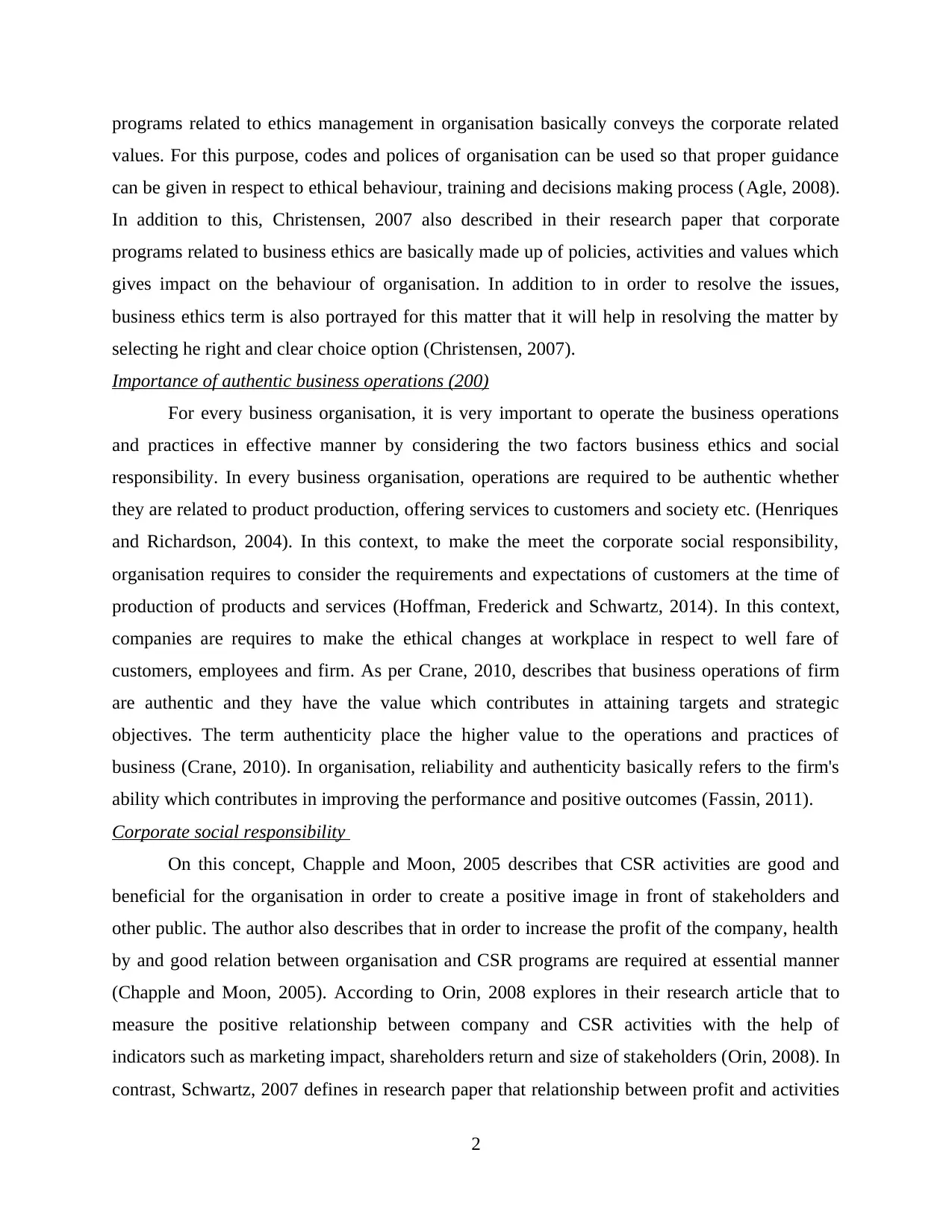
programs related to ethics management in organisation basically conveys the corporate related
values. For this purpose, codes and polices of organisation can be used so that proper guidance
can be given in respect to ethical behaviour, training and decisions making process (Agle, 2008).
In addition to this, Christensen, 2007 also described in their research paper that corporate
programs related to business ethics are basically made up of policies, activities and values which
gives impact on the behaviour of organisation. In addition to in order to resolve the issues,
business ethics term is also portrayed for this matter that it will help in resolving the matter by
selecting he right and clear choice option (Christensen, 2007).
Importance of authentic business operations (200)
For every business organisation, it is very important to operate the business operations
and practices in effective manner by considering the two factors business ethics and social
responsibility. In every business organisation, operations are required to be authentic whether
they are related to product production, offering services to customers and society etc. (Henriques
and Richardson, 2004). In this context, to make the meet the corporate social responsibility,
organisation requires to consider the requirements and expectations of customers at the time of
production of products and services (Hoffman, Frederick and Schwartz, 2014). In this context,
companies are requires to make the ethical changes at workplace in respect to well fare of
customers, employees and firm. As per Crane, 2010, describes that business operations of firm
are authentic and they have the value which contributes in attaining targets and strategic
objectives. The term authenticity place the higher value to the operations and practices of
business (Crane, 2010). In organisation, reliability and authenticity basically refers to the firm's
ability which contributes in improving the performance and positive outcomes (Fassin, 2011).
Corporate social responsibility
On this concept, Chapple and Moon, 2005 describes that CSR activities are good and
beneficial for the organisation in order to create a positive image in front of stakeholders and
other public. The author also describes that in order to increase the profit of the company, health
by and good relation between organisation and CSR programs are required at essential manner
(Chapple and Moon, 2005). According to Orin, 2008 explores in their research article that to
measure the positive relationship between company and CSR activities with the help of
indicators such as marketing impact, shareholders return and size of stakeholders (Orin, 2008). In
contrast, Schwartz, 2007 defines in research paper that relationship between profit and activities
2
values. For this purpose, codes and polices of organisation can be used so that proper guidance
can be given in respect to ethical behaviour, training and decisions making process (Agle, 2008).
In addition to this, Christensen, 2007 also described in their research paper that corporate
programs related to business ethics are basically made up of policies, activities and values which
gives impact on the behaviour of organisation. In addition to in order to resolve the issues,
business ethics term is also portrayed for this matter that it will help in resolving the matter by
selecting he right and clear choice option (Christensen, 2007).
Importance of authentic business operations (200)
For every business organisation, it is very important to operate the business operations
and practices in effective manner by considering the two factors business ethics and social
responsibility. In every business organisation, operations are required to be authentic whether
they are related to product production, offering services to customers and society etc. (Henriques
and Richardson, 2004). In this context, to make the meet the corporate social responsibility,
organisation requires to consider the requirements and expectations of customers at the time of
production of products and services (Hoffman, Frederick and Schwartz, 2014). In this context,
companies are requires to make the ethical changes at workplace in respect to well fare of
customers, employees and firm. As per Crane, 2010, describes that business operations of firm
are authentic and they have the value which contributes in attaining targets and strategic
objectives. The term authenticity place the higher value to the operations and practices of
business (Crane, 2010). In organisation, reliability and authenticity basically refers to the firm's
ability which contributes in improving the performance and positive outcomes (Fassin, 2011).
Corporate social responsibility
On this concept, Chapple and Moon, 2005 describes that CSR activities are good and
beneficial for the organisation in order to create a positive image in front of stakeholders and
other public. The author also describes that in order to increase the profit of the company, health
by and good relation between organisation and CSR programs are required at essential manner
(Chapple and Moon, 2005). According to Orin, 2008 explores in their research article that to
measure the positive relationship between company and CSR activities with the help of
indicators such as marketing impact, shareholders return and size of stakeholders (Orin, 2008). In
contrast, Schwartz, 2007 defines in research paper that relationship between profit and activities
2
⊘ This is a preview!⊘
Do you want full access?
Subscribe today to unlock all pages.

Trusted by 1+ million students worldwide
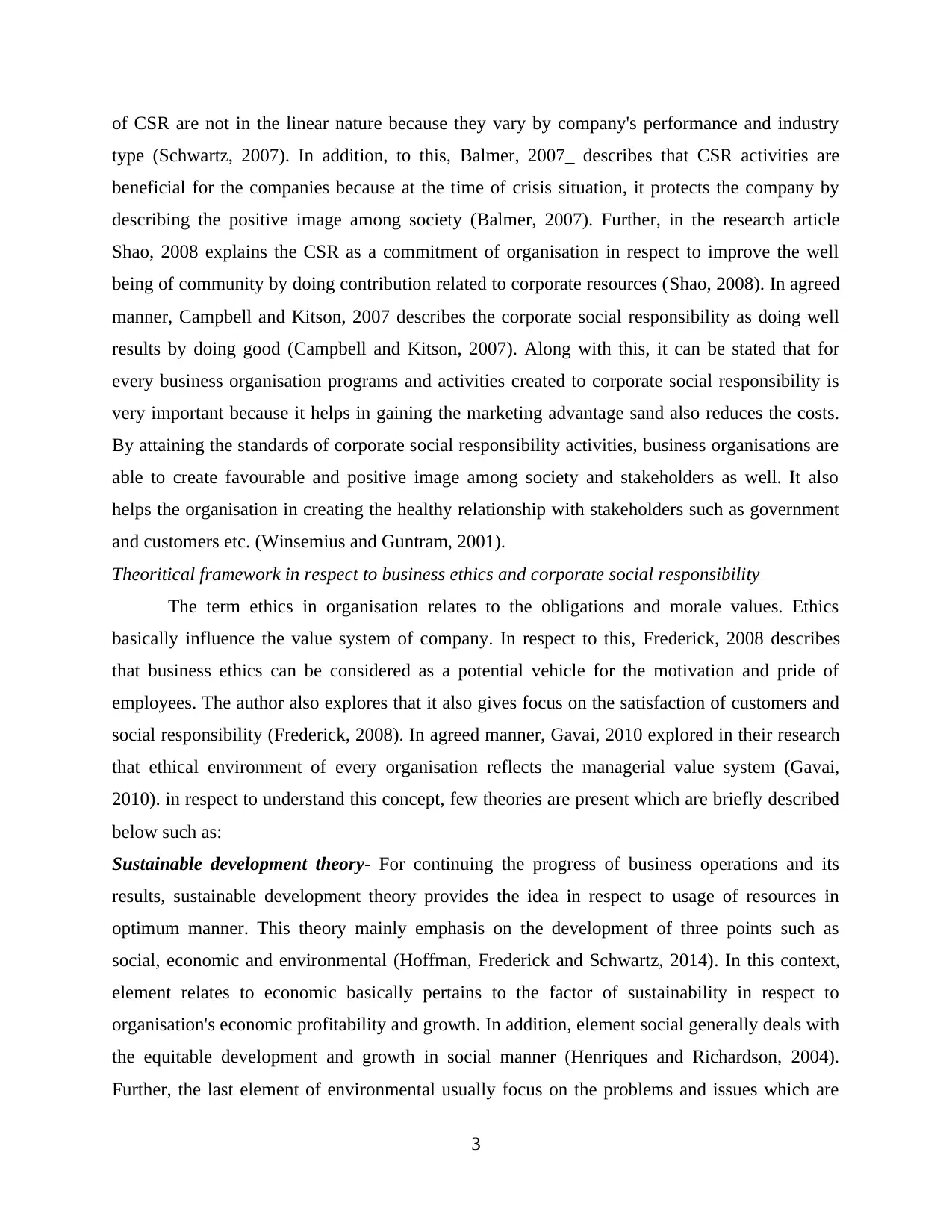
of CSR are not in the linear nature because they vary by company's performance and industry
type (Schwartz, 2007). In addition, to this, Balmer, 2007_ describes that CSR activities are
beneficial for the companies because at the time of crisis situation, it protects the company by
describing the positive image among society (Balmer, 2007). Further, in the research article
Shao, 2008 explains the CSR as a commitment of organisation in respect to improve the well
being of community by doing contribution related to corporate resources (Shao, 2008). In agreed
manner, Campbell and Kitson, 2007 describes the corporate social responsibility as doing well
results by doing good (Campbell and Kitson, 2007). Along with this, it can be stated that for
every business organisation programs and activities created to corporate social responsibility is
very important because it helps in gaining the marketing advantage sand also reduces the costs.
By attaining the standards of corporate social responsibility activities, business organisations are
able to create favourable and positive image among society and stakeholders as well. It also
helps the organisation in creating the healthy relationship with stakeholders such as government
and customers etc. (Winsemius and Guntram, 2001).
Theoritical framework in respect to business ethics and corporate social responsibility
The term ethics in organisation relates to the obligations and morale values. Ethics
basically influence the value system of company. In respect to this, Frederick, 2008 describes
that business ethics can be considered as a potential vehicle for the motivation and pride of
employees. The author also explores that it also gives focus on the satisfaction of customers and
social responsibility (Frederick, 2008). In agreed manner, Gavai, 2010 explored in their research
that ethical environment of every organisation reflects the managerial value system (Gavai,
2010). in respect to understand this concept, few theories are present which are briefly described
below such as:
Sustainable development theory- For continuing the progress of business operations and its
results, sustainable development theory provides the idea in respect to usage of resources in
optimum manner. This theory mainly emphasis on the development of three points such as
social, economic and environmental (Hoffman, Frederick and Schwartz, 2014). In this context,
element relates to economic basically pertains to the factor of sustainability in respect to
organisation's economic profitability and growth. In addition, element social generally deals with
the equitable development and growth in social manner (Henriques and Richardson, 2004).
Further, the last element of environmental usually focus on the problems and issues which are
3
type (Schwartz, 2007). In addition, to this, Balmer, 2007_ describes that CSR activities are
beneficial for the companies because at the time of crisis situation, it protects the company by
describing the positive image among society (Balmer, 2007). Further, in the research article
Shao, 2008 explains the CSR as a commitment of organisation in respect to improve the well
being of community by doing contribution related to corporate resources (Shao, 2008). In agreed
manner, Campbell and Kitson, 2007 describes the corporate social responsibility as doing well
results by doing good (Campbell and Kitson, 2007). Along with this, it can be stated that for
every business organisation programs and activities created to corporate social responsibility is
very important because it helps in gaining the marketing advantage sand also reduces the costs.
By attaining the standards of corporate social responsibility activities, business organisations are
able to create favourable and positive image among society and stakeholders as well. It also
helps the organisation in creating the healthy relationship with stakeholders such as government
and customers etc. (Winsemius and Guntram, 2001).
Theoritical framework in respect to business ethics and corporate social responsibility
The term ethics in organisation relates to the obligations and morale values. Ethics
basically influence the value system of company. In respect to this, Frederick, 2008 describes
that business ethics can be considered as a potential vehicle for the motivation and pride of
employees. The author also explores that it also gives focus on the satisfaction of customers and
social responsibility (Frederick, 2008). In agreed manner, Gavai, 2010 explored in their research
that ethical environment of every organisation reflects the managerial value system (Gavai,
2010). in respect to understand this concept, few theories are present which are briefly described
below such as:
Sustainable development theory- For continuing the progress of business operations and its
results, sustainable development theory provides the idea in respect to usage of resources in
optimum manner. This theory mainly emphasis on the development of three points such as
social, economic and environmental (Hoffman, Frederick and Schwartz, 2014). In this context,
element relates to economic basically pertains to the factor of sustainability in respect to
organisation's economic profitability and growth. In addition, element social generally deals with
the equitable development and growth in social manner (Henriques and Richardson, 2004).
Further, the last element of environmental usually focus on the problems and issues which are
3
Paraphrase This Document
Need a fresh take? Get an instant paraphrase of this document with our AI Paraphraser
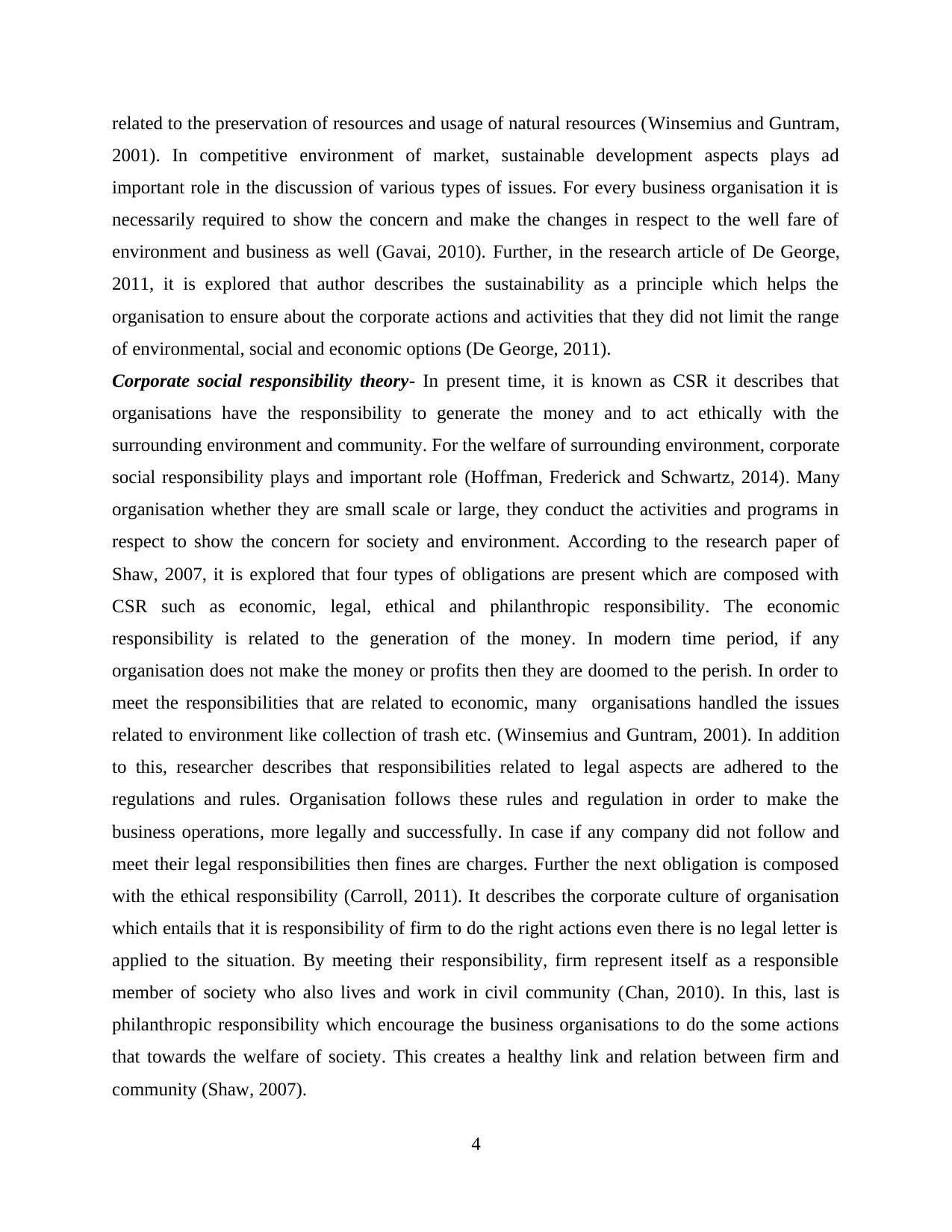
related to the preservation of resources and usage of natural resources (Winsemius and Guntram,
2001). In competitive environment of market, sustainable development aspects plays ad
important role in the discussion of various types of issues. For every business organisation it is
necessarily required to show the concern and make the changes in respect to the well fare of
environment and business as well (Gavai, 2010). Further, in the research article of De George,
2011, it is explored that author describes the sustainability as a principle which helps the
organisation to ensure about the corporate actions and activities that they did not limit the range
of environmental, social and economic options (De George, 2011).
Corporate social responsibility theory- In present time, it is known as CSR it describes that
organisations have the responsibility to generate the money and to act ethically with the
surrounding environment and community. For the welfare of surrounding environment, corporate
social responsibility plays and important role (Hoffman, Frederick and Schwartz, 2014). Many
organisation whether they are small scale or large, they conduct the activities and programs in
respect to show the concern for society and environment. According to the research paper of
Shaw, 2007, it is explored that four types of obligations are present which are composed with
CSR such as economic, legal, ethical and philanthropic responsibility. The economic
responsibility is related to the generation of the money. In modern time period, if any
organisation does not make the money or profits then they are doomed to the perish. In order to
meet the responsibilities that are related to economic, many organisations handled the issues
related to environment like collection of trash etc. (Winsemius and Guntram, 2001). In addition
to this, researcher describes that responsibilities related to legal aspects are adhered to the
regulations and rules. Organisation follows these rules and regulation in order to make the
business operations, more legally and successfully. In case if any company did not follow and
meet their legal responsibilities then fines are charges. Further the next obligation is composed
with the ethical responsibility (Carroll, 2011). It describes the corporate culture of organisation
which entails that it is responsibility of firm to do the right actions even there is no legal letter is
applied to the situation. By meeting their responsibility, firm represent itself as a responsible
member of society who also lives and work in civil community (Chan, 2010). In this, last is
philanthropic responsibility which encourage the business organisations to do the some actions
that towards the welfare of society. This creates a healthy link and relation between firm and
community (Shaw, 2007).
4
2001). In competitive environment of market, sustainable development aspects plays ad
important role in the discussion of various types of issues. For every business organisation it is
necessarily required to show the concern and make the changes in respect to the well fare of
environment and business as well (Gavai, 2010). Further, in the research article of De George,
2011, it is explored that author describes the sustainability as a principle which helps the
organisation to ensure about the corporate actions and activities that they did not limit the range
of environmental, social and economic options (De George, 2011).
Corporate social responsibility theory- In present time, it is known as CSR it describes that
organisations have the responsibility to generate the money and to act ethically with the
surrounding environment and community. For the welfare of surrounding environment, corporate
social responsibility plays and important role (Hoffman, Frederick and Schwartz, 2014). Many
organisation whether they are small scale or large, they conduct the activities and programs in
respect to show the concern for society and environment. According to the research paper of
Shaw, 2007, it is explored that four types of obligations are present which are composed with
CSR such as economic, legal, ethical and philanthropic responsibility. The economic
responsibility is related to the generation of the money. In modern time period, if any
organisation does not make the money or profits then they are doomed to the perish. In order to
meet the responsibilities that are related to economic, many organisations handled the issues
related to environment like collection of trash etc. (Winsemius and Guntram, 2001). In addition
to this, researcher describes that responsibilities related to legal aspects are adhered to the
regulations and rules. Organisation follows these rules and regulation in order to make the
business operations, more legally and successfully. In case if any company did not follow and
meet their legal responsibilities then fines are charges. Further the next obligation is composed
with the ethical responsibility (Carroll, 2011). It describes the corporate culture of organisation
which entails that it is responsibility of firm to do the right actions even there is no legal letter is
applied to the situation. By meeting their responsibility, firm represent itself as a responsible
member of society who also lives and work in civil community (Chan, 2010). In this, last is
philanthropic responsibility which encourage the business organisations to do the some actions
that towards the welfare of society. This creates a healthy link and relation between firm and
community (Shaw, 2007).
4
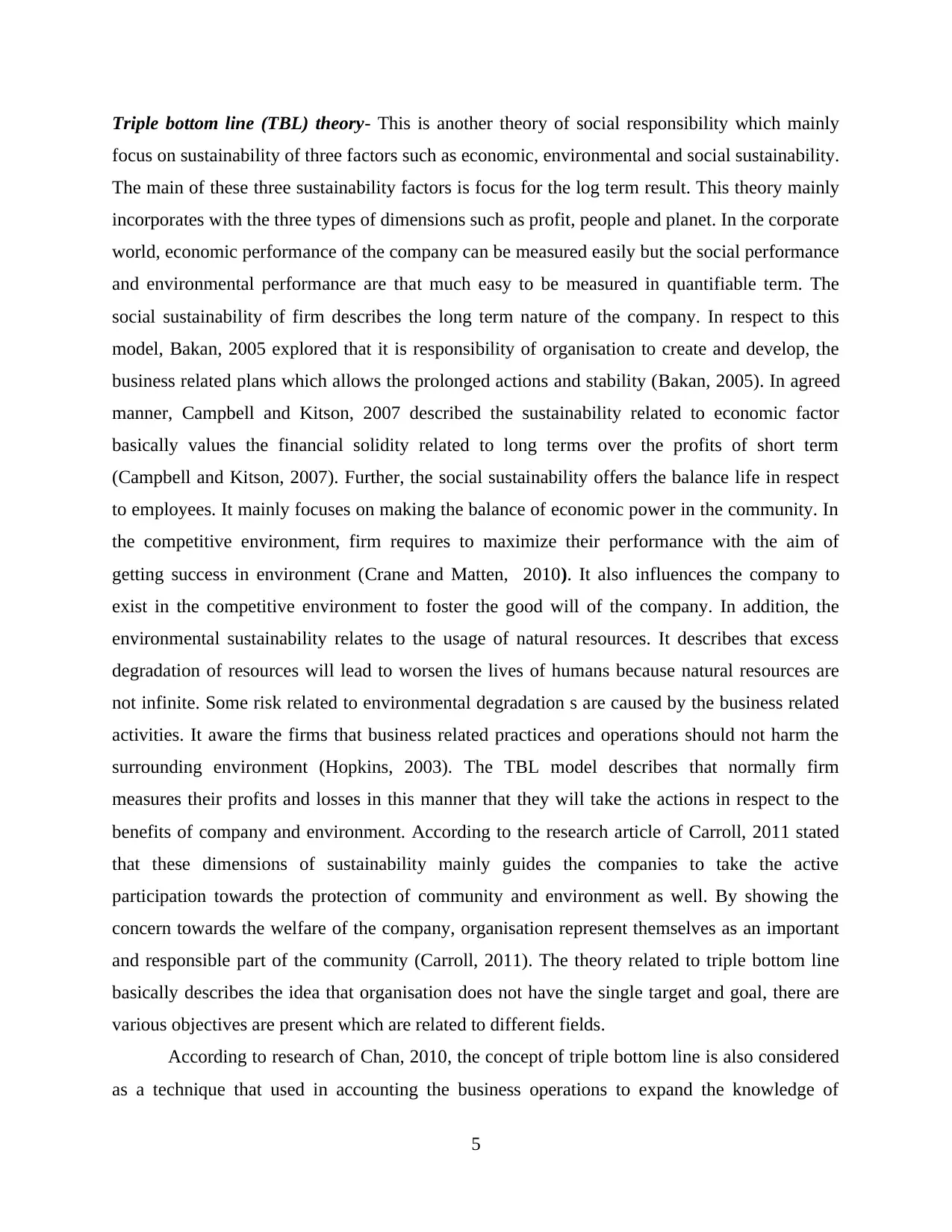
Triple bottom line (TBL) theory- This is another theory of social responsibility which mainly
focus on sustainability of three factors such as economic, environmental and social sustainability.
The main of these three sustainability factors is focus for the log term result. This theory mainly
incorporates with the three types of dimensions such as profit, people and planet. In the corporate
world, economic performance of the company can be measured easily but the social performance
and environmental performance are that much easy to be measured in quantifiable term. The
social sustainability of firm describes the long term nature of the company. In respect to this
model, Bakan, 2005 explored that it is responsibility of organisation to create and develop, the
business related plans which allows the prolonged actions and stability (Bakan, 2005). In agreed
manner, Campbell and Kitson, 2007 described the sustainability related to economic factor
basically values the financial solidity related to long terms over the profits of short term
(Campbell and Kitson, 2007). Further, the social sustainability offers the balance life in respect
to employees. It mainly focuses on making the balance of economic power in the community. In
the competitive environment, firm requires to maximize their performance with the aim of
getting success in environment (Crane and Matten, 2010). It also influences the company to
exist in the competitive environment to foster the good will of the company. In addition, the
environmental sustainability relates to the usage of natural resources. It describes that excess
degradation of resources will lead to worsen the lives of humans because natural resources are
not infinite. Some risk related to environmental degradation s are caused by the business related
activities. It aware the firms that business related practices and operations should not harm the
surrounding environment (Hopkins, 2003). The TBL model describes that normally firm
measures their profits and losses in this manner that they will take the actions in respect to the
benefits of company and environment. According to the research article of Carroll, 2011 stated
that these dimensions of sustainability mainly guides the companies to take the active
participation towards the protection of community and environment as well. By showing the
concern towards the welfare of the company, organisation represent themselves as an important
and responsible part of the community (Carroll, 2011). The theory related to triple bottom line
basically describes the idea that organisation does not have the single target and goal, there are
various objectives are present which are related to different fields.
According to research of Chan, 2010, the concept of triple bottom line is also considered
as a technique that used in accounting the business operations to expand the knowledge of
5
focus on sustainability of three factors such as economic, environmental and social sustainability.
The main of these three sustainability factors is focus for the log term result. This theory mainly
incorporates with the three types of dimensions such as profit, people and planet. In the corporate
world, economic performance of the company can be measured easily but the social performance
and environmental performance are that much easy to be measured in quantifiable term. The
social sustainability of firm describes the long term nature of the company. In respect to this
model, Bakan, 2005 explored that it is responsibility of organisation to create and develop, the
business related plans which allows the prolonged actions and stability (Bakan, 2005). In agreed
manner, Campbell and Kitson, 2007 described the sustainability related to economic factor
basically values the financial solidity related to long terms over the profits of short term
(Campbell and Kitson, 2007). Further, the social sustainability offers the balance life in respect
to employees. It mainly focuses on making the balance of economic power in the community. In
the competitive environment, firm requires to maximize their performance with the aim of
getting success in environment (Crane and Matten, 2010). It also influences the company to
exist in the competitive environment to foster the good will of the company. In addition, the
environmental sustainability relates to the usage of natural resources. It describes that excess
degradation of resources will lead to worsen the lives of humans because natural resources are
not infinite. Some risk related to environmental degradation s are caused by the business related
activities. It aware the firms that business related practices and operations should not harm the
surrounding environment (Hopkins, 2003). The TBL model describes that normally firm
measures their profits and losses in this manner that they will take the actions in respect to the
benefits of company and environment. According to the research article of Carroll, 2011 stated
that these dimensions of sustainability mainly guides the companies to take the active
participation towards the protection of community and environment as well. By showing the
concern towards the welfare of the company, organisation represent themselves as an important
and responsible part of the community (Carroll, 2011). The theory related to triple bottom line
basically describes the idea that organisation does not have the single target and goal, there are
various objectives are present which are related to different fields.
According to research of Chan, 2010, the concept of triple bottom line is also considered
as a technique that used in accounting the business operations to expand the knowledge of
5
⊘ This is a preview!⊘
Do you want full access?
Subscribe today to unlock all pages.

Trusted by 1+ million students worldwide
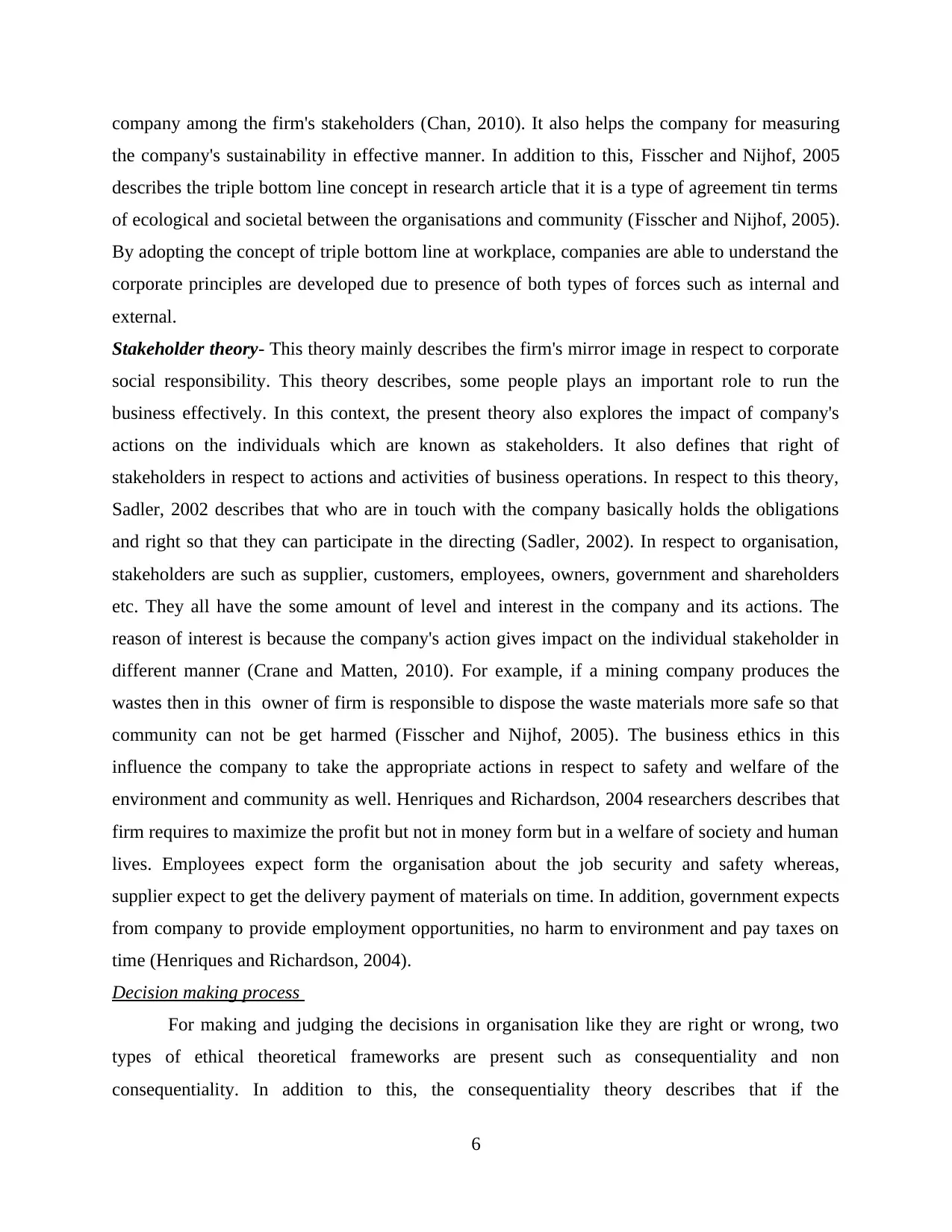
company among the firm's stakeholders (Chan, 2010). It also helps the company for measuring
the company's sustainability in effective manner. In addition to this, Fisscher and Nijhof, 2005
describes the triple bottom line concept in research article that it is a type of agreement tin terms
of ecological and societal between the organisations and community (Fisscher and Nijhof, 2005).
By adopting the concept of triple bottom line at workplace, companies are able to understand the
corporate principles are developed due to presence of both types of forces such as internal and
external.
Stakeholder theory- This theory mainly describes the firm's mirror image in respect to corporate
social responsibility. This theory describes, some people plays an important role to run the
business effectively. In this context, the present theory also explores the impact of company's
actions on the individuals which are known as stakeholders. It also defines that right of
stakeholders in respect to actions and activities of business operations. In respect to this theory,
Sadler, 2002 describes that who are in touch with the company basically holds the obligations
and right so that they can participate in the directing (Sadler, 2002). In respect to organisation,
stakeholders are such as supplier, customers, employees, owners, government and shareholders
etc. They all have the some amount of level and interest in the company and its actions. The
reason of interest is because the company's action gives impact on the individual stakeholder in
different manner (Crane and Matten, 2010). For example, if a mining company produces the
wastes then in this owner of firm is responsible to dispose the waste materials more safe so that
community can not be get harmed (Fisscher and Nijhof, 2005). The business ethics in this
influence the company to take the appropriate actions in respect to safety and welfare of the
environment and community as well. Henriques and Richardson, 2004 researchers describes that
firm requires to maximize the profit but not in money form but in a welfare of society and human
lives. Employees expect form the organisation about the job security and safety whereas,
supplier expect to get the delivery payment of materials on time. In addition, government expects
from company to provide employment opportunities, no harm to environment and pay taxes on
time (Henriques and Richardson, 2004).
Decision making process
For making and judging the decisions in organisation like they are right or wrong, two
types of ethical theoretical frameworks are present such as consequentiality and non
consequentiality. In addition to this, the consequentiality theory describes that if the
6
the company's sustainability in effective manner. In addition to this, Fisscher and Nijhof, 2005
describes the triple bottom line concept in research article that it is a type of agreement tin terms
of ecological and societal between the organisations and community (Fisscher and Nijhof, 2005).
By adopting the concept of triple bottom line at workplace, companies are able to understand the
corporate principles are developed due to presence of both types of forces such as internal and
external.
Stakeholder theory- This theory mainly describes the firm's mirror image in respect to corporate
social responsibility. This theory describes, some people plays an important role to run the
business effectively. In this context, the present theory also explores the impact of company's
actions on the individuals which are known as stakeholders. It also defines that right of
stakeholders in respect to actions and activities of business operations. In respect to this theory,
Sadler, 2002 describes that who are in touch with the company basically holds the obligations
and right so that they can participate in the directing (Sadler, 2002). In respect to organisation,
stakeholders are such as supplier, customers, employees, owners, government and shareholders
etc. They all have the some amount of level and interest in the company and its actions. The
reason of interest is because the company's action gives impact on the individual stakeholder in
different manner (Crane and Matten, 2010). For example, if a mining company produces the
wastes then in this owner of firm is responsible to dispose the waste materials more safe so that
community can not be get harmed (Fisscher and Nijhof, 2005). The business ethics in this
influence the company to take the appropriate actions in respect to safety and welfare of the
environment and community as well. Henriques and Richardson, 2004 researchers describes that
firm requires to maximize the profit but not in money form but in a welfare of society and human
lives. Employees expect form the organisation about the job security and safety whereas,
supplier expect to get the delivery payment of materials on time. In addition, government expects
from company to provide employment opportunities, no harm to environment and pay taxes on
time (Henriques and Richardson, 2004).
Decision making process
For making and judging the decisions in organisation like they are right or wrong, two
types of ethical theoretical frameworks are present such as consequentiality and non
consequentiality. In addition to this, the consequentiality theory describes that if the
6
Paraphrase This Document
Need a fresh take? Get an instant paraphrase of this document with our AI Paraphraser
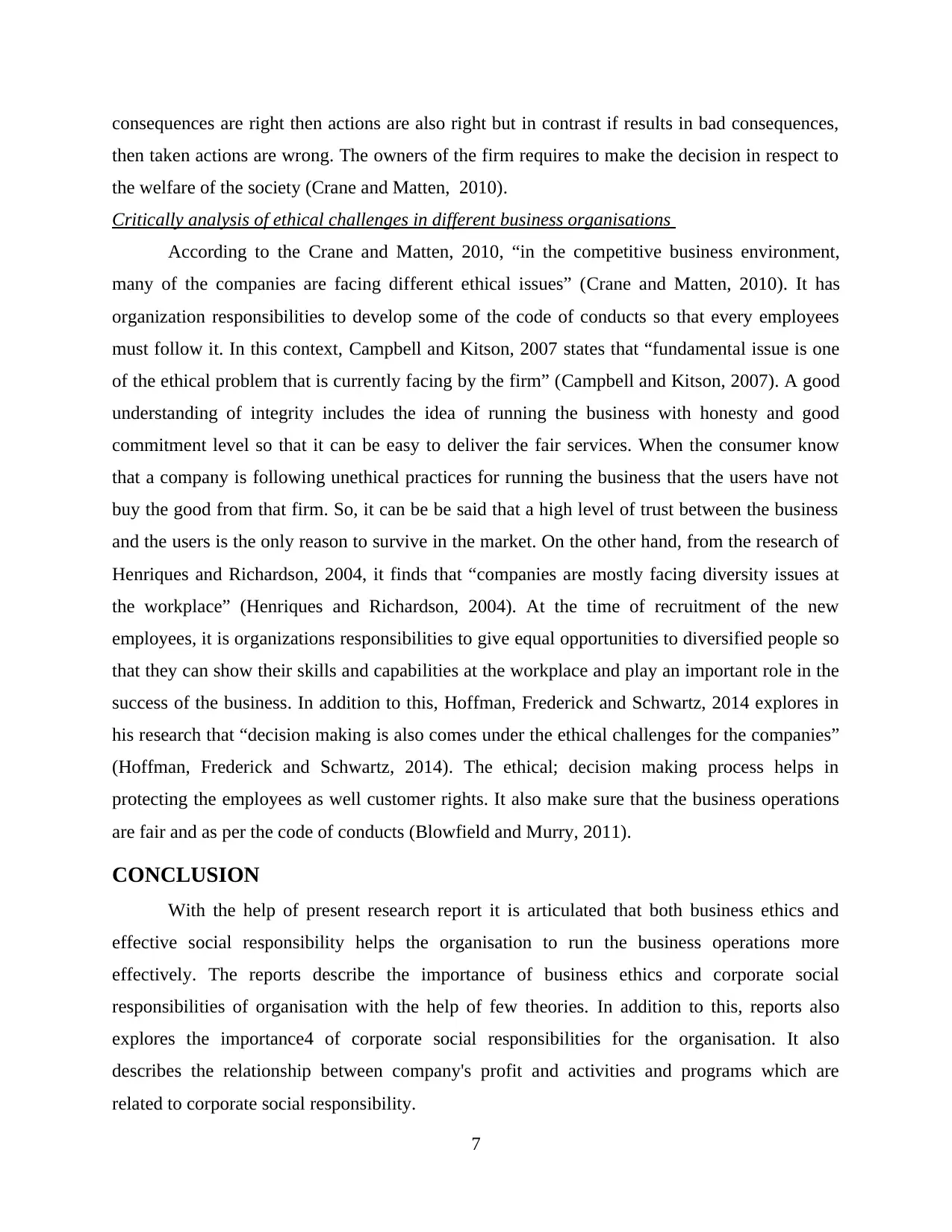
consequences are right then actions are also right but in contrast if results in bad consequences,
then taken actions are wrong. The owners of the firm requires to make the decision in respect to
the welfare of the society (Crane and Matten, 2010).
Critically analysis of ethical challenges in different business organisations
According to the Crane and Matten, 2010, “in the competitive business environment,
many of the companies are facing different ethical issues” (Crane and Matten, 2010). It has
organization responsibilities to develop some of the code of conducts so that every employees
must follow it. In this context, Campbell and Kitson, 2007 states that “fundamental issue is one
of the ethical problem that is currently facing by the firm” (Campbell and Kitson, 2007). A good
understanding of integrity includes the idea of running the business with honesty and good
commitment level so that it can be easy to deliver the fair services. When the consumer know
that a company is following unethical practices for running the business that the users have not
buy the good from that firm. So, it can be be said that a high level of trust between the business
and the users is the only reason to survive in the market. On the other hand, from the research of
Henriques and Richardson, 2004, it finds that “companies are mostly facing diversity issues at
the workplace” (Henriques and Richardson, 2004). At the time of recruitment of the new
employees, it is organizations responsibilities to give equal opportunities to diversified people so
that they can show their skills and capabilities at the workplace and play an important role in the
success of the business. In addition to this, Hoffman, Frederick and Schwartz, 2014 explores in
his research that “decision making is also comes under the ethical challenges for the companies”
(Hoffman, Frederick and Schwartz, 2014). The ethical; decision making process helps in
protecting the employees as well customer rights. It also make sure that the business operations
are fair and as per the code of conducts (Blowfield and Murry, 2011).
CONCLUSION
With the help of present research report it is articulated that both business ethics and
effective social responsibility helps the organisation to run the business operations more
effectively. The reports describe the importance of business ethics and corporate social
responsibilities of organisation with the help of few theories. In addition to this, reports also
explores the importance4 of corporate social responsibilities for the organisation. It also
describes the relationship between company's profit and activities and programs which are
related to corporate social responsibility.
7
then taken actions are wrong. The owners of the firm requires to make the decision in respect to
the welfare of the society (Crane and Matten, 2010).
Critically analysis of ethical challenges in different business organisations
According to the Crane and Matten, 2010, “in the competitive business environment,
many of the companies are facing different ethical issues” (Crane and Matten, 2010). It has
organization responsibilities to develop some of the code of conducts so that every employees
must follow it. In this context, Campbell and Kitson, 2007 states that “fundamental issue is one
of the ethical problem that is currently facing by the firm” (Campbell and Kitson, 2007). A good
understanding of integrity includes the idea of running the business with honesty and good
commitment level so that it can be easy to deliver the fair services. When the consumer know
that a company is following unethical practices for running the business that the users have not
buy the good from that firm. So, it can be be said that a high level of trust between the business
and the users is the only reason to survive in the market. On the other hand, from the research of
Henriques and Richardson, 2004, it finds that “companies are mostly facing diversity issues at
the workplace” (Henriques and Richardson, 2004). At the time of recruitment of the new
employees, it is organizations responsibilities to give equal opportunities to diversified people so
that they can show their skills and capabilities at the workplace and play an important role in the
success of the business. In addition to this, Hoffman, Frederick and Schwartz, 2014 explores in
his research that “decision making is also comes under the ethical challenges for the companies”
(Hoffman, Frederick and Schwartz, 2014). The ethical; decision making process helps in
protecting the employees as well customer rights. It also make sure that the business operations
are fair and as per the code of conducts (Blowfield and Murry, 2011).
CONCLUSION
With the help of present research report it is articulated that both business ethics and
effective social responsibility helps the organisation to run the business operations more
effectively. The reports describe the importance of business ethics and corporate social
responsibilities of organisation with the help of few theories. In addition to this, reports also
explores the importance4 of corporate social responsibilities for the organisation. It also
describes the relationship between company's profit and activities and programs which are
related to corporate social responsibility.
7
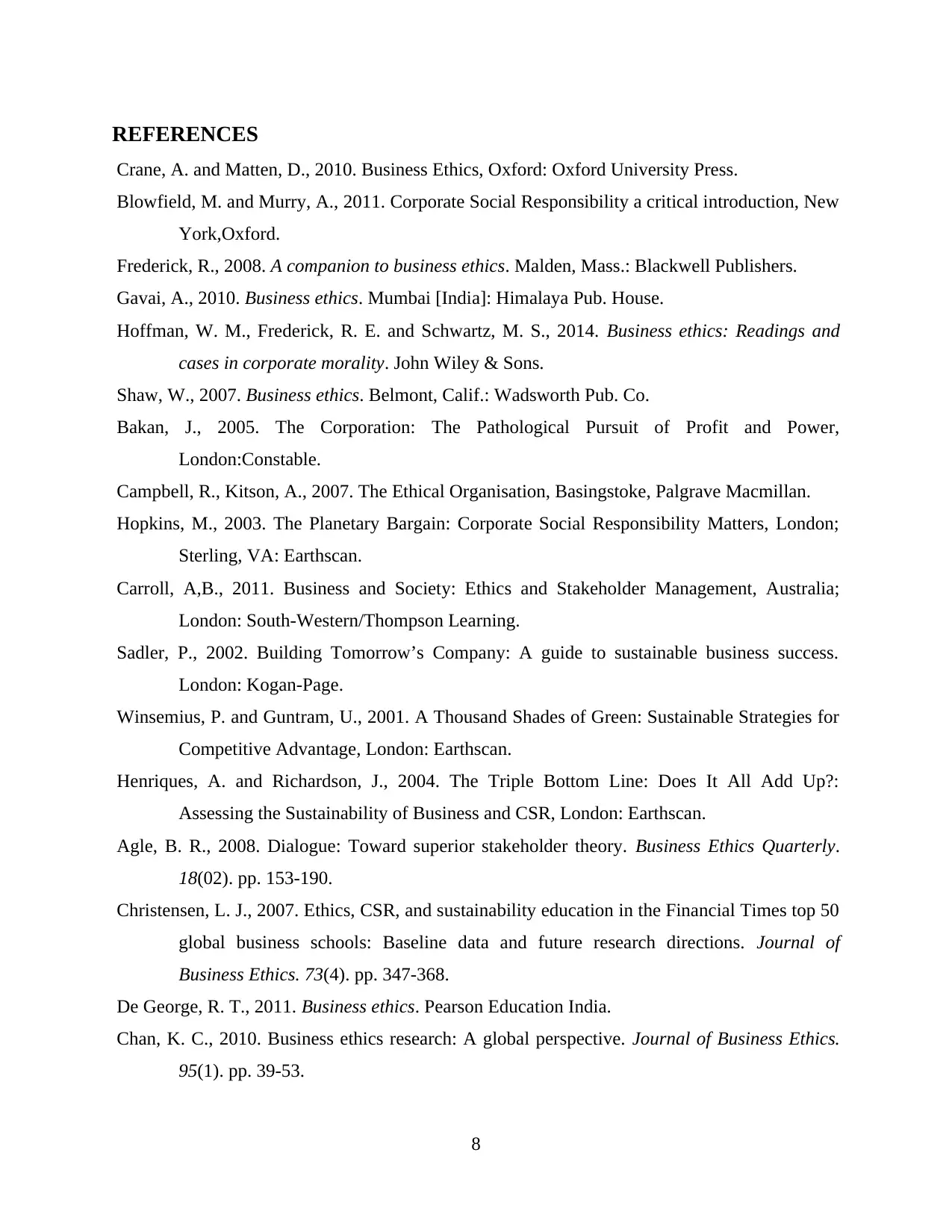
REFERENCES
Crane, A. and Matten, D., 2010. Business Ethics, Oxford: Oxford University Press.
Blowfield, M. and Murry, A., 2011. Corporate Social Responsibility a critical introduction, New
York,Oxford.
Frederick, R., 2008. A companion to business ethics. Malden, Mass.: Blackwell Publishers.
Gavai, A., 2010. Business ethics. Mumbai [India]: Himalaya Pub. House.
Hoffman, W. M., Frederick, R. E. and Schwartz, M. S., 2014. Business ethics: Readings and
cases in corporate morality. John Wiley & Sons.
Shaw, W., 2007. Business ethics. Belmont, Calif.: Wadsworth Pub. Co.
Bakan, J., 2005. The Corporation: The Pathological Pursuit of Profit and Power,
London:Constable.
Campbell, R., Kitson, A., 2007. The Ethical Organisation, Basingstoke, Palgrave Macmillan.
Hopkins, M., 2003. The Planetary Bargain: Corporate Social Responsibility Matters, London;
Sterling, VA: Earthscan.
Carroll, A,B., 2011. Business and Society: Ethics and Stakeholder Management, Australia;
London: South-Western/Thompson Learning.
Sadler, P., 2002. Building Tomorrow’s Company: A guide to sustainable business success.
London: Kogan-Page.
Winsemius, P. and Guntram, U., 2001. A Thousand Shades of Green: Sustainable Strategies for
Competitive Advantage, London: Earthscan.
Henriques, A. and Richardson, J., 2004. The Triple Bottom Line: Does It All Add Up?:
Assessing the Sustainability of Business and CSR, London: Earthscan.
Agle, B. R., 2008. Dialogue: Toward superior stakeholder theory. Business Ethics Quarterly.
18(02). pp. 153-190.
Christensen, L. J., 2007. Ethics, CSR, and sustainability education in the Financial Times top 50
global business schools: Baseline data and future research directions. Journal of
Business Ethics. 73(4). pp. 347-368.
De George, R. T., 2011. Business ethics. Pearson Education India.
Chan, K. C., 2010. Business ethics research: A global perspective. Journal of Business Ethics.
95(1). pp. 39-53.
8
Crane, A. and Matten, D., 2010. Business Ethics, Oxford: Oxford University Press.
Blowfield, M. and Murry, A., 2011. Corporate Social Responsibility a critical introduction, New
York,Oxford.
Frederick, R., 2008. A companion to business ethics. Malden, Mass.: Blackwell Publishers.
Gavai, A., 2010. Business ethics. Mumbai [India]: Himalaya Pub. House.
Hoffman, W. M., Frederick, R. E. and Schwartz, M. S., 2014. Business ethics: Readings and
cases in corporate morality. John Wiley & Sons.
Shaw, W., 2007. Business ethics. Belmont, Calif.: Wadsworth Pub. Co.
Bakan, J., 2005. The Corporation: The Pathological Pursuit of Profit and Power,
London:Constable.
Campbell, R., Kitson, A., 2007. The Ethical Organisation, Basingstoke, Palgrave Macmillan.
Hopkins, M., 2003. The Planetary Bargain: Corporate Social Responsibility Matters, London;
Sterling, VA: Earthscan.
Carroll, A,B., 2011. Business and Society: Ethics and Stakeholder Management, Australia;
London: South-Western/Thompson Learning.
Sadler, P., 2002. Building Tomorrow’s Company: A guide to sustainable business success.
London: Kogan-Page.
Winsemius, P. and Guntram, U., 2001. A Thousand Shades of Green: Sustainable Strategies for
Competitive Advantage, London: Earthscan.
Henriques, A. and Richardson, J., 2004. The Triple Bottom Line: Does It All Add Up?:
Assessing the Sustainability of Business and CSR, London: Earthscan.
Agle, B. R., 2008. Dialogue: Toward superior stakeholder theory. Business Ethics Quarterly.
18(02). pp. 153-190.
Christensen, L. J., 2007. Ethics, CSR, and sustainability education in the Financial Times top 50
global business schools: Baseline data and future research directions. Journal of
Business Ethics. 73(4). pp. 347-368.
De George, R. T., 2011. Business ethics. Pearson Education India.
Chan, K. C., 2010. Business ethics research: A global perspective. Journal of Business Ethics.
95(1). pp. 39-53.
8
⊘ This is a preview!⊘
Do you want full access?
Subscribe today to unlock all pages.

Trusted by 1+ million students worldwide
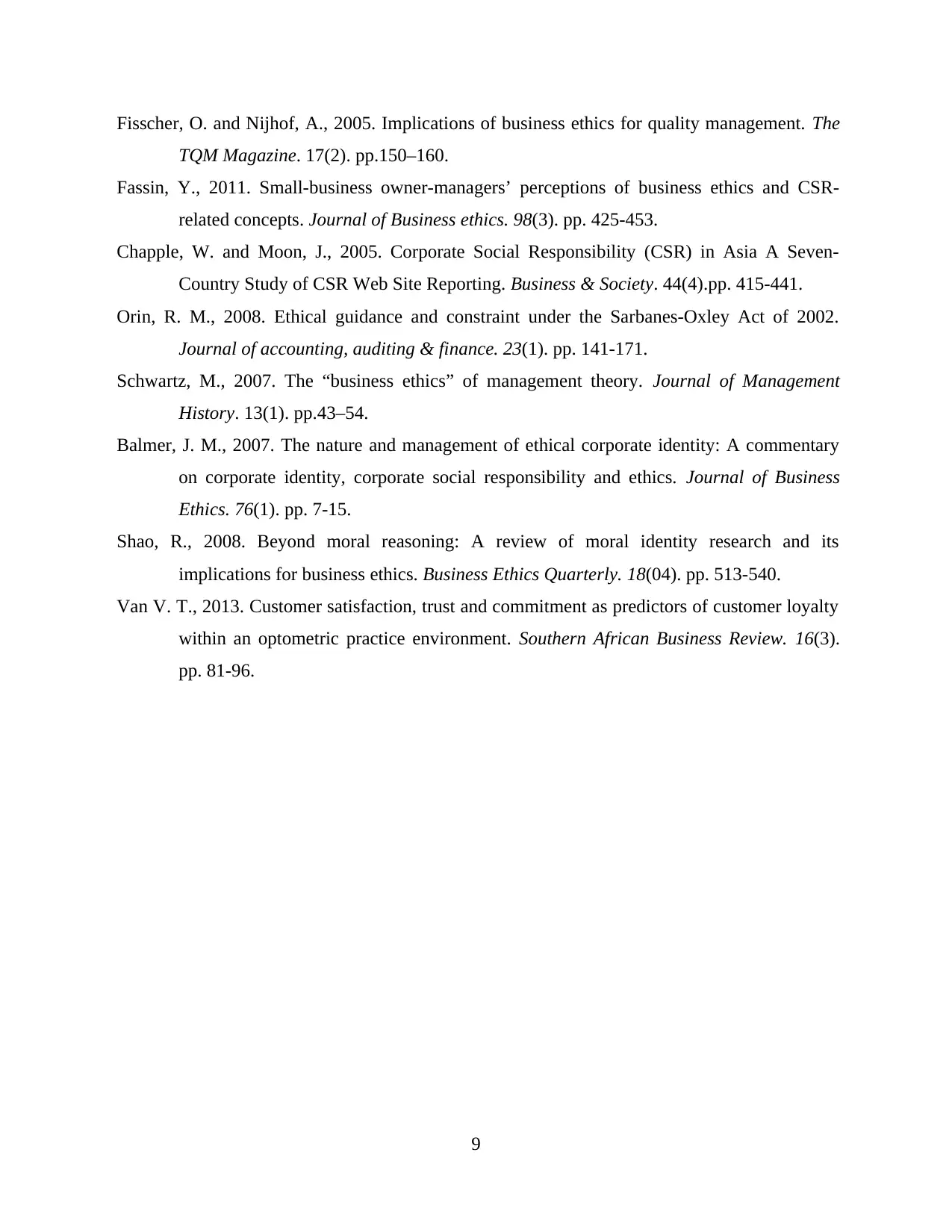
Fisscher, O. and Nijhof, A., 2005. Implications of business ethics for quality management. The
TQM Magazine. 17(2). pp.150–160.
Fassin, Y., 2011. Small-business owner-managers’ perceptions of business ethics and CSR-
related concepts. Journal of Business ethics. 98(3). pp. 425-453.
Chapple, W. and Moon, J., 2005. Corporate Social Responsibility (CSR) in Asia A Seven-
Country Study of CSR Web Site Reporting. Business & Society. 44(4).pp. 415-441.
Orin, R. M., 2008. Ethical guidance and constraint under the Sarbanes-Oxley Act of 2002.
Journal of accounting, auditing & finance. 23(1). pp. 141-171.
Schwartz, M., 2007. The “business ethics” of management theory. Journal of Management
History. 13(1). pp.43–54.
Balmer, J. M., 2007. The nature and management of ethical corporate identity: A commentary
on corporate identity, corporate social responsibility and ethics. Journal of Business
Ethics. 76(1). pp. 7-15.
Shao, R., 2008. Beyond moral reasoning: A review of moral identity research and its
implications for business ethics. Business Ethics Quarterly. 18(04). pp. 513-540.
Van V. T., 2013. Customer satisfaction, trust and commitment as predictors of customer loyalty
within an optometric practice environment. Southern African Business Review. 16(3).
pp. 81-96.
9
TQM Magazine. 17(2). pp.150–160.
Fassin, Y., 2011. Small-business owner-managers’ perceptions of business ethics and CSR-
related concepts. Journal of Business ethics. 98(3). pp. 425-453.
Chapple, W. and Moon, J., 2005. Corporate Social Responsibility (CSR) in Asia A Seven-
Country Study of CSR Web Site Reporting. Business & Society. 44(4).pp. 415-441.
Orin, R. M., 2008. Ethical guidance and constraint under the Sarbanes-Oxley Act of 2002.
Journal of accounting, auditing & finance. 23(1). pp. 141-171.
Schwartz, M., 2007. The “business ethics” of management theory. Journal of Management
History. 13(1). pp.43–54.
Balmer, J. M., 2007. The nature and management of ethical corporate identity: A commentary
on corporate identity, corporate social responsibility and ethics. Journal of Business
Ethics. 76(1). pp. 7-15.
Shao, R., 2008. Beyond moral reasoning: A review of moral identity research and its
implications for business ethics. Business Ethics Quarterly. 18(04). pp. 513-540.
Van V. T., 2013. Customer satisfaction, trust and commitment as predictors of customer loyalty
within an optometric practice environment. Southern African Business Review. 16(3).
pp. 81-96.
9
1 out of 10
Related Documents
Your All-in-One AI-Powered Toolkit for Academic Success.
+13062052269
info@desklib.com
Available 24*7 on WhatsApp / Email
![[object Object]](/_next/static/media/star-bottom.7253800d.svg)
Unlock your academic potential
Copyright © 2020–2025 A2Z Services. All Rights Reserved. Developed and managed by ZUCOL.





